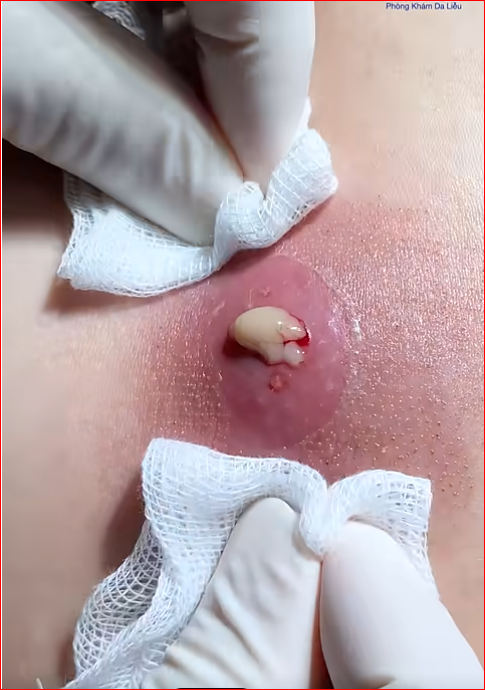How to Treat a Large Abscess:
-
Medical Evaluation
-
See a doctor — large abscesses usually need professional care.
-
-
Incision and Drainage (I&D)
-
The standard treatment: a healthcare provider numbs the area, makes a small cut, and drains the pus.
-
Sometimes they pack it with gauze to keep it open and drain fully.
-
-
Antibiotics
-
Given if the infection is spreading, the patient has a fever, or they have a weakened immune system.
-
Not always needed if drainage is complete and there’s no surrounding infection.
-
-
Wound Care
-
Clean daily, change dressings, and monitor for signs of infection (redness, swelling, pain, pus, fever).
-
-
Pain Control
-
Over-the-counter pain relievers like ibuprofen or acetaminophen can help.
-
👉 Don’t try to pop or squeeze a large abscess yourself. It can spread the infection or make things worse.
🩺 Management of Large Abscesses
1. Diagnosis and Initial Assessment
-
Clinical Presentation: Large abscesses typically present as painful, red, and swollen areas under the skin, often with a fluctuant center indicating pus accumulation. Accompanying symptoms may include fever and regional lymphadenopathy.
-
Etiology: The majority of skin abscesses are caused by Staphylococcus aureus, including methicillin-resistant strains (MRSA) .Verywell Health+2IDSA Home+2PubMed+2
-
Indications for Medical Evaluation:
-
Abscesses located in high-risk areas (e.g., face, hands, perirectal region).
-
Presence of systemic symptoms such as fever or chills.
-
Abscesses in immunocompromised individuals.
-
Abscesses that are large, deep, or not responding to initial treatment .MSF Medical Guidelines
-
2. Incision and Drainage (I&D)
-
Procedure:
-
Performed under sterile conditions with local anesthesia.
-
A scalpel is used to make an incision at the most fluctuant part of the abscess.
-
The cavity is explored digitally to break up loculations, and pus is evacuated.
-
The cavity is irrigated with saline to remove debris .IDSA Home
-
-
Wound Management:
-
Post-procedure, a sterile dressing is applied.
-
In some cases, a drain or gauze wick may be inserted to facilitate ongoing drainage, though evidence suggests that routine packing may not be necessary and can cause increased pain without improving healing .PubMed
-
3. Antibiotic Therapy
-
Indications for Antibiotics:
-
Presence of systemic symptoms (e.g., fever, elevated white blood cell count).
-
Abscesses with extensive surrounding cellulitis.
-
Immunocompromised patients or those with comorbid conditions (e.g., diabetes) .MSF Medical Guidelines+1PMC+1
-
-
Empiric Antibiotic Selection:
-
Coverage for Staphylococcus aureus, including MRSA, is recommended.
-
Common choices include trimethoprim-sulfamethoxazole (TMP-SMX), clindamycin, or doxycycline .The Hospitalist
-
-
Efficacy of Antibiotics Post-I&D:
-
Studies indicate that adding antibiotics after I&D may improve cure rates and reduce recurrence, particularly in culture-positive cases .
-
However, in immunocompetent patients without systemic symptoms, I&D alone may suffice .PubMed+2The Hospitalist+2PubMed+2PubMed
-
4. Wound Care and Follow-Up
-
Post-Procedure Care:
-
Keep the wound clean and dry.
-
Apply warm compresses to the area to promote drainage.
-
Change dressings as recommended by healthcare providers .
-
-
Signs of Complications:
-
Increased redness, swelling, or pain.
-
Foul-smelling or purulent discharge.
-
Development of fever or chills.
-
These may indicate persistent infection or abscess recurrence and warrant medical attention .
-
-
Follow-Up:
-
Schedule a follow-up appointment within 3–5 days to assess healing and determine if further intervention is needed.
-
⚠️ Special Considerations
-
High-Risk Locations: Abscesses in areas such as the face, hands, perirectal region, or near major blood vessels require careful assessment and may necessitate referral to a specialist .MSF Medical Guidelines
-
Immunocompromised Patients: Individuals with conditions like diabetes, HIV, or those on immunosuppressive therapy are at higher risk for complications and should receive prompt and aggressive treatment.PMC
-
Recurrent Abscesses: Consideration of underlying conditions such as hidradenitis suppurativa or colonization with MRSA may be necessary.
